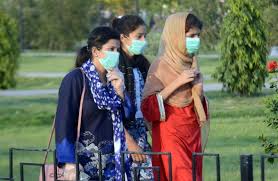Wearing face masks best way to reduce coronavirus transmission: study

Islamabad: Researchers who have been studying coronavirus mitigation measures in three heavily affected parts of the world have concluded that wearing a face mask is the most effective way to stop the spread of COVID-19.
Their study, published in Proceedings of the National Academy of Sciences, looked at three virus epicentres: New York, Italy and Wuhan. It compared the rate of spread before and after the countries implemented protective measures.
“Our analysis indicates that face covering reduced the number of infections by over 78,000 in Italy from April 6 to May 9 and by over 66,000 in NYC from April 17 to May 9,” read the paper.
The dates mentioned are when each country made it compulsory for the public to wear masks.
China was the first to flatten the curve of infections, the researchers said, but since it mplemented all measures simultaneously, their individual effects could not be studied.
They attributed China’s success to extensive testing, quarantine, contact tracing and aggressive measures such as a complete lockdown in the whole country, isolation of contacts and making wearing masks mandatory.
The reason behind the success of masks lies in identifying the primary mode of virus transmission, which the study says was airborne through aerosols.
“With typical nasal breathing (ie at a velocity of ∼1 m⋅s−1), inhalation of airborne viruses leads to direct and continuous deposition into the human respiratory tract,” said the authors.
A face mask or covering prevents airborne transmission by blocking inhalation of virus-laden aerosols and contact transmission by blocking viral shedding of droplets.
The study said that other mitigation measures, such as social distancing and stay-at-home orders aren’t enough to protect people.
It adds that the failure to control the COVID-19 pandemic is mainly due to the “unrecognized importance of airborne virus transmission.”
The novel coronavirus can spread by direct contact when an infected person coughs or sneezes on another person or indirect contact, when the infected person coughs or sneezes on an object.
Large virus-laden droplets fall to the ground and smaller droplets, called aerosols, can travel several feet and stay in the air for a while.
The World Health Organisation changed its guidelines on wearing masks on June 5. The organisation recommended everyone should wear a mask at all times outdoors. Previously, it had said masks were only necessary for health workers, those with COVID-19 and those taking care of them.
An ideal mask, according to the WHO, has three different layers. An innermost layer made of absorbent material like cotton, a middle layer of non-woven material such as polypropylene to act as a filter and an outer layer of non-absorbent material like polyester.
